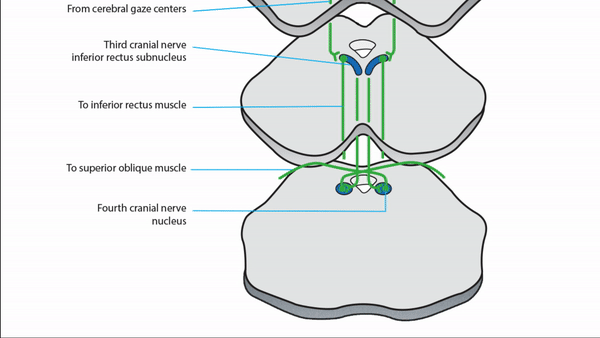Pursuit Pathway
-
Horizontal pursuit
- Signal travels from the eyes to the visual cortex, then to the occipital-temporal junctional center, which connects to the front gaze center; the signal then travels downward to the dorsolateral pontine nuclei (DPLN), cerebellar vermis, nucleus prepositus hypoglossi, medial vestibular nucleus and sixth nerve nucleus
- From the sixth nerve nucleus, the signal travels via sixth nerve axons to the ipsilateral lateral rectus muscle and via the medial longitudinal fasciculus (MLF) to the contralateral medial rectus subnucleus and via third nerve axons to the contralateral medial rectus muscle
-
Vertical pursuit
- Signal travels from occipital-parietal centers in both hemispheres to the brainstem, eventually reaching the appropriate ocular motor nuclei and ocular motor nerves that mediate upward and downward pursuit








-
Unilateral parieto-occipital lesion
- Impairs ipsilateral horizontal pursuit, clinically detectable as saccadic pursuit when the eyes track an object moving toward the lesioned hemisphere and as relatively reduced contraversive saccadic amplitude when the optokinetic strip is moved toward the side of the lesion
-
Tip: this deficit is not often detected on clinical examination, but is evident on testing in sophisticated eye movement laboratories
- Bilateral parieto-occipital lesions
-
Thalamic or midbrain lesions
- Impair mostly upward pursuit, saccades, and the vestibulo-ocular reflex
-
Pontine lesions
- Impair mostly horizontal pursuit, saccades, and the vestibulo-ocular reflex
-
Medullary or cerebellar lesions
- Impair pursuit, saccades, and the vestibulo-ocular reflex in all directions

